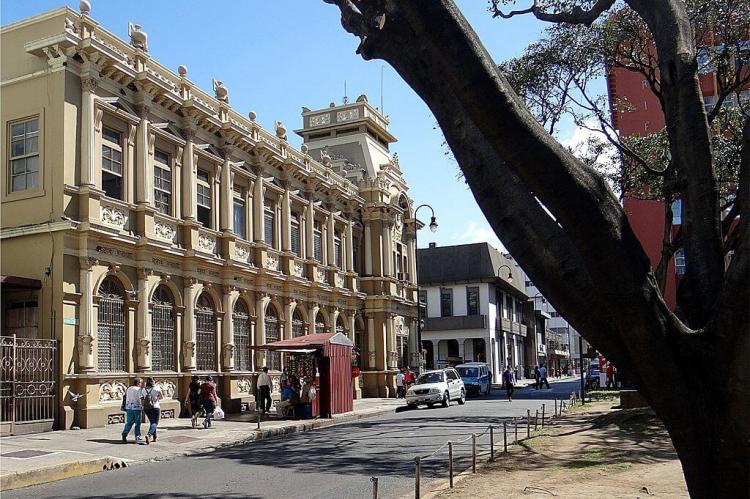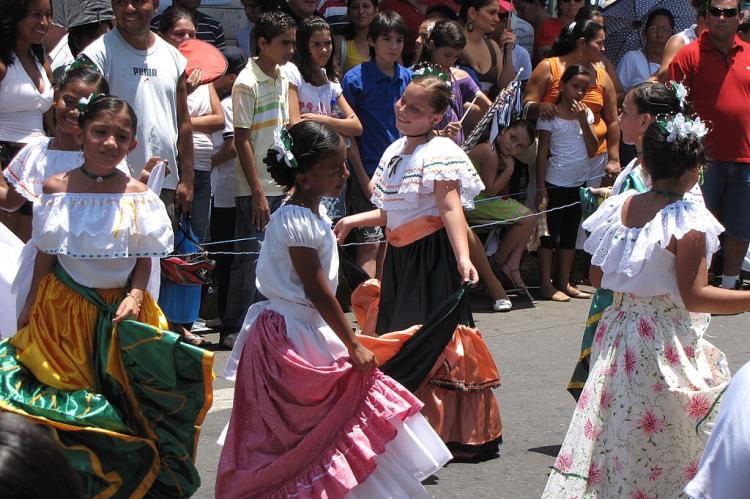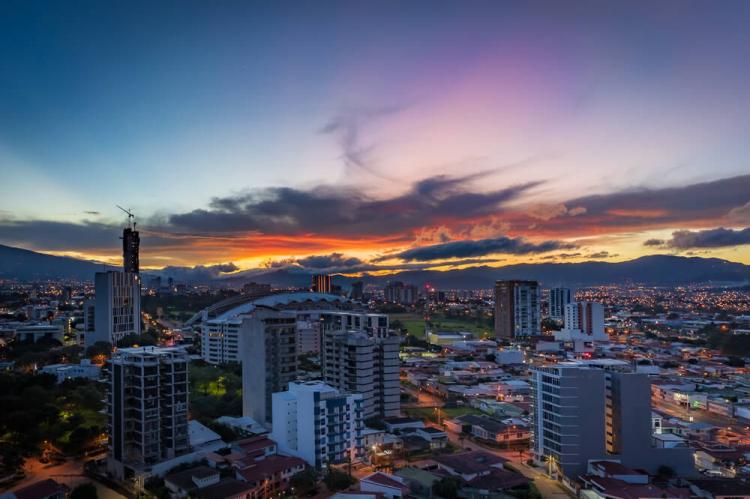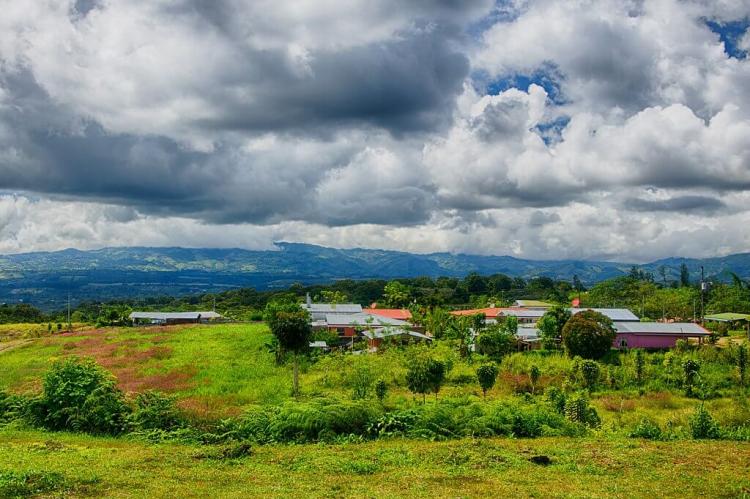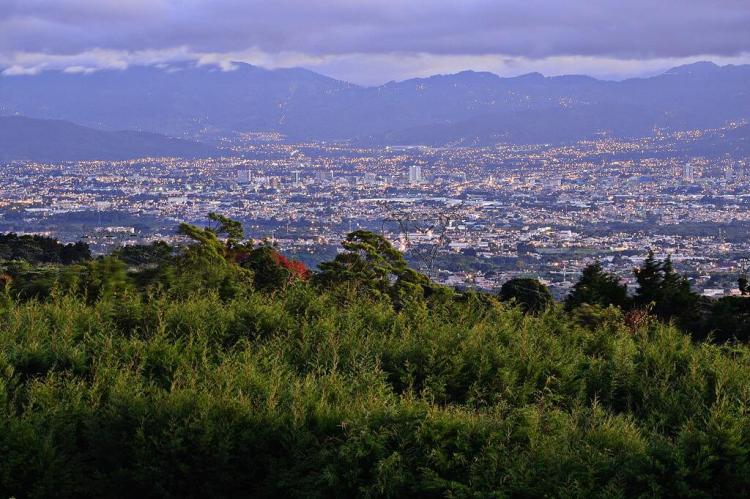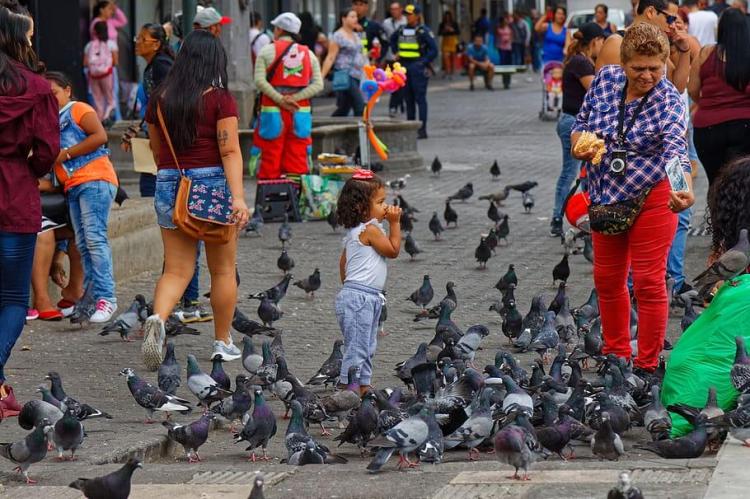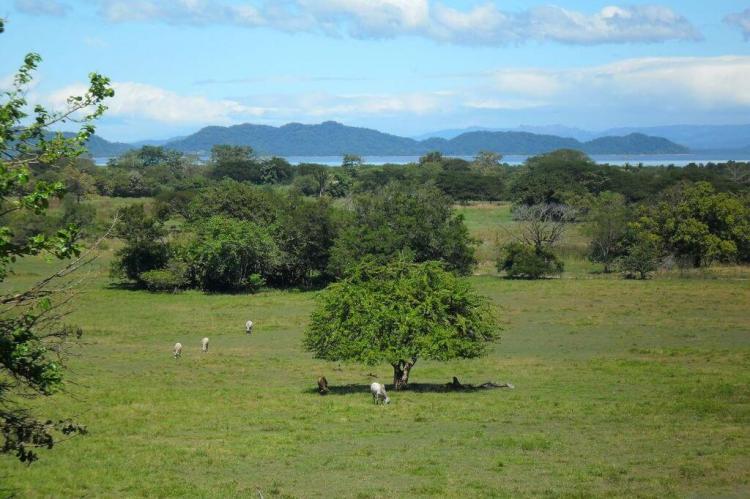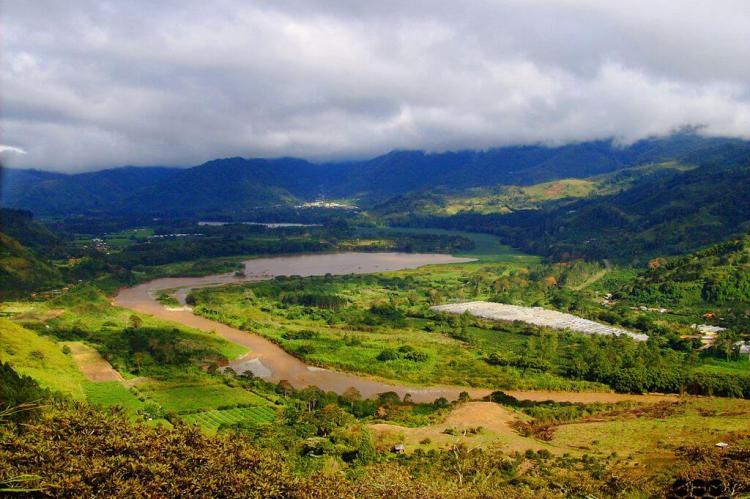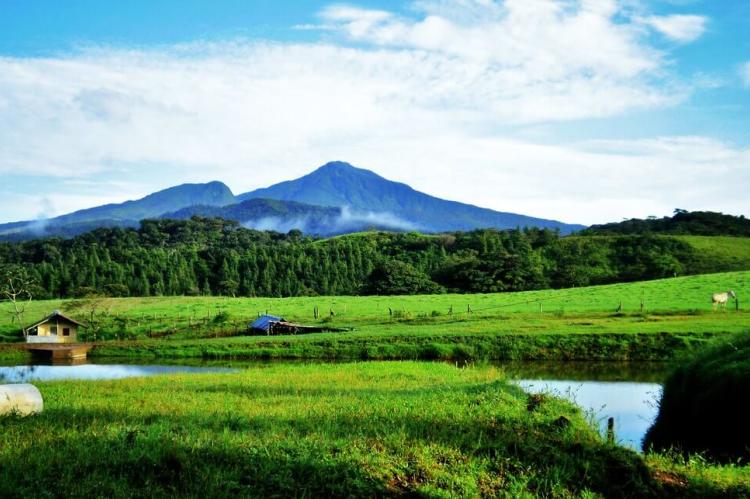Costa Rica: Cultural Landscape
Costa Rica, located in Central America, boasts a rich and diverse cultural landscape shaped by its history, natural beauty, and ethnic diversity. It combines historical influences, vibrant traditions, environmental stewardship, and a love for life, making it a unique and fascinating destination.
The Cultural Landscape of Costa Rica
Costa Rica, located in Central America, boasts a rich and diverse cultural landscape shaped by its history, natural beauty, and ethnic diversity. The cultural landscape of Costa Rica combines historical influences, vibrant traditions, environmental stewardship, and a love for life, making it a unique and fascinating destination.
-
Pre-Columbian Heritage: Before the arrival of the Spanish, Costa Rica was inhabited by indigenous groups such as the Chorotega, Huetar, and Bribrí. Their influence can still be seen in traditional crafts, art, and agricultural practices.
-
Spanish Colonial Legacy: Spanish colonization played a significant role in shaping Costa Rican culture. Architecture, religious traditions, language (Spanish), and the Catholic faith are enduring aspects of the colonial legacy.
-
Pura Vida Lifestyle: Costa Ricans embrace a laid-back and optimistic philosophy called "Pura Vida." This mantra encapsulates the country's emphasis on enjoying life, valuing nature, and fostering a warm, friendly, and hospitable community spirit.
-
Biodiversity and Conservation: Costa Rica is renowned for its incredible biodiversity and commitment to environmental preservation. The country's national parks, protected areas, and eco-tourism initiatives reflect a deep appreciation for nature and sustainable practices.
-
Arts and Music: Traditional Costa Rican art encompasses handcrafted items like wooden masks, pottery, and woven textiles, often inspired by indigenous motifs. In addition, traditional music, such as marimba and folk dances like the "Punto Guanacasteco," remains integral to the cultural fabric.
-
Festivals and Celebrations: Costa Rica celebrates various festivals throughout the year, reflecting its religious, historical, and agricultural traditions. The Fiestas de Zapote, Semana Santa (Holy Week), and Independence Day are some notable festivities showcasing Costa Rican culture, music, dance, and cuisine.
-
Gastronomy: Costa Rican cuisine reflects indigenous, Spanish, and Afro-Caribbean influences. Gallo Pinto (rice and beans), ceviche, plantains, casado (a traditional dish with rice, beans, meat, and vegetables), and delicious tropical fruits like mango and pineapple are popular culinary delights.
-
Sports: Football (soccer) is the most popular sport in Costa Rica, ingrained in the country's culture. The national team's success and passionate support from fans have made football an essential part of Costa Rican identity.
-
Ethnic Diversity: While Costa Rica predominantly has a mestizo (mixed European and indigenous) heritage, it embraces cultural diversity. Afro-Costa Rican communities on the Caribbean coast and indigenous populations in various regions contribute to the country's multicultural tapestry.
Contemporary Influences on Costa Rican Culture
These are just a few of the contemporary influences on Costa Rican culture. The country is a dynamic and evolving society whose culture constantly changes.
-
Globalization: Costa Rica is a small country with just over 5 million people. As a result, it is heavily influenced by globalization. This can be seen in the country's cuisine, a mix of European, African, and South American influences, and in its music, which blends traditional Costa Rican rhythms with Latin American and global sounds.
-
Immigration: Costa Rica has a long history of immigration, and this continues to be a significant factor in shaping the country's culture. In recent years, there has been a substantial increase in the number of immigrants from Nicaragua, Panama, and the United States. These immigrants have brought their own cultures, adding to Costa Rican society's diversity.
-
Technology: Technology is another significant influence on Costa Rican culture. The Internet and mobile phones have become ubiquitous in Costa Rica, profoundly impacting how people communicate, learn, and consume entertainment.
-
The Arts: The arts are also significant in Costa Rican culture. The country has a thriving theater scene, a vibrant music scene, and a growing visual arts scene. The arts allow Costa Ricans to express their identity and connect.
Challenges Facing Costa Rican Culture
These are just some of the challenges facing Costa Rican culture today. The country faces several complex challenges but is also a resilient society with a rich culture. It remains to be seen how Costa Ricans will overcome these challenges and shape their culture in the future.
-
Economic Inequality: Costa Rica has a relatively high level of economic inequality. This is due to several factors, including the country's history of dictatorship, its reliance on agriculture, and proximity to Nicaragua. The economic disparity is causing social tensions and is making it difficult for Costa Ricans to share in the country's economic prosperity.
-
Environmental Degradation: Costa Rica faces several environmental challenges, including deforestation, pollution, and climate change. These challenges harm the country's natural resources and threaten many Costa Ricans' livelihoods.
-
Political Polarization: Costa Rica has a long history of political stability. However, the country has become increasingly polarized in recent years. This polarization makes it difficult for the government to address the country's challenges.
-
Tourism: Costa Rica is a popular tourist destination, which has led to several challenges, including environmental degradation, cultural appropriation, and the exploitation of workers.
-
Violence: Costa Rica has a relatively low level of violence compared to other countries in Latin America. However, the country has seen increased violence in recent years, particularly in the capital city of San José. This violence is a challenge to Costa Rican culture, making it difficult for the country to maintain its reputation as a safe and peaceful destination.
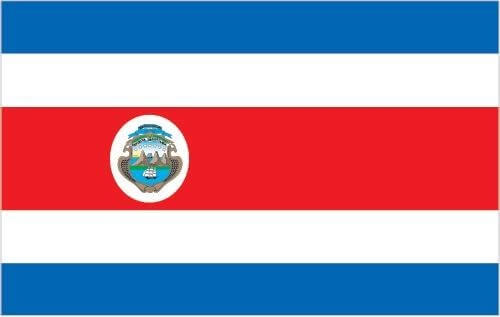
The official flag of Costa Rica
Cultural Geography of Costa Rica
Largest Cities / Metro Areas
Ranked by population estimate (2023):
-
San José (335,000): San José is the capital and largest city of Costa Rica. Located in the central part of the country, it serves as the nation's political, economic, and cultural hub. The city offers a mix of modern infrastructure and historical charm, with its urban landscape featuring a blend of colonial-era architecture and contemporary buildings. San José has numerous museums, galleries, theaters, and cultural institutions.
-
Limón (63,000): Limón is a coastal city located on the Caribbean coast of Costa Rica. It's the capital of Limón Province and is known for its vibrant Afro-Caribbean culture, lush tropical landscapes, and bustling port. The city's cultural diversity is reflected in its festivals, music, cuisine, and traditions, influenced by its residents' African, Indigenous, and European heritage.
-
San Francisco (56,000): San Francisco, Costa Rica, is a district located within the greater metropolitan area of San José, the capital city. As a suburban area, San Francisco offers a mix of residential and commercial features, making it an integral part of the capital's urban fabric. Being situated near San José, residents of San Francisco have access to the amenities and services of the capital city.
-
Alajuela (47,500): Alajuela serves as the capital of the Alajuela province. It's known for its historical significance, coffee plantations, and proximity to Juan Santamaría International Airport. The city offers a mix of urban amenities and natural attractions.
-
Liberia (45,300): Liberia is the capital of the Guanacaste province and is known as the "White City" due to its whitewashed buildings. It's a gateway to exploring the beaches, national parks, and volcanic landscapes of the Guanacaste region.
-
Paraiso (39,700): Paraíso is a city in the Cartago Province of Costa Rica. Nestled in the picturesque Orosi Valley, Paraíso is known for its serene landscapes, rich history, and cultural attractions.
-
Puntarenas (35,600): Puntarenas is the capital city of the Puntarenas province and is located on the Pacific coast. It's a major port and a popular destination for beachgoers and tourists seeking marine adventures.
-
San Isidro (34,800): San Isidro de El General, commonly known as San Isidro, is a city located in the Perez Zeledón canton of Costa Rica. Situated in the country's southern region, San Isidro is known for its role as a commercial and agricultural hub and its proximity to diverse natural attractions.
-
Curridabat (34,500): Curridabat is a suburb located east of San José. It's known for its upscale neighborhoods, commercial centers, and proximity to natural attractions. The city offers a mix of urban living and green spaces.
-
San Vicente (34,400): San Vicente is a district within the San José metropolitan area. It's primarily a residential area with a mix of housing and urban services.
Administrative Divisions
Costa Rica is constitutionally divided into seven provinces, further divided into 82 cantons and 473 districts.
Provinces
The provinces of Costa Rica, their capitals, and a brief description are as follows:
-
San José (Capital: San José): San José is the capital and largest province of Costa Rica. It's the country's political, economic, and cultural center, housing numerous museums, theaters, and government institutions. The bustling cityscape is balanced by nearby natural attractions, making it a dynamic urban hub.
-
Alajuela (Capital: Alajuela): Alajuela is known for its agricultural landscapes and coffee plantations. It's home to Juan Santamaría International Airport and offers easy access to popular destinations like Arenal Volcano and the Poás Volcano National Park.
-
Cartago (Capital: Cartago): Cartago was the original capital of Costa Rica and is rich in historical significance. It's home to the Basilica of Our Lady of the Angels, a significant pilgrimage site with colonial-era architecture. Lush valleys and natural beauty surround the province.
-
Heredia (Capital: Heredia): Heredia is known as the "City of Flowers" due to its beautiful gardens and landscapes. The province is characterized by its agricultural production, including coffee and ornamental plants. The city of Heredia has a charming colonial center.
-
Guanacaste (Capital: Liberia): Guanacaste is famous for its stunning beaches, national parks, and biodiversity. It's a popular destination for tourists seeking sun, surf, and adventure. Liberia, the capital, is a gateway to the province's attractions.
-
Puntarenas (Capital: Puntarenas): Puntarenas is a coastal province known for its extensive coastline, beaches, and marine life. It offers opportunities for eco-tourism, sport fishing, and relaxation. The capital city, also named Puntarenas, is a major port.
-
Limón (Capital: Puerto Limón): Limón is on the Caribbean coast, known for its vibrant Afro-Caribbean culture and tropical landscapes. It's a gateway to exploring the Tortuguero National Park and the region's natural wonders. Puerto Limón serves as a significant port.
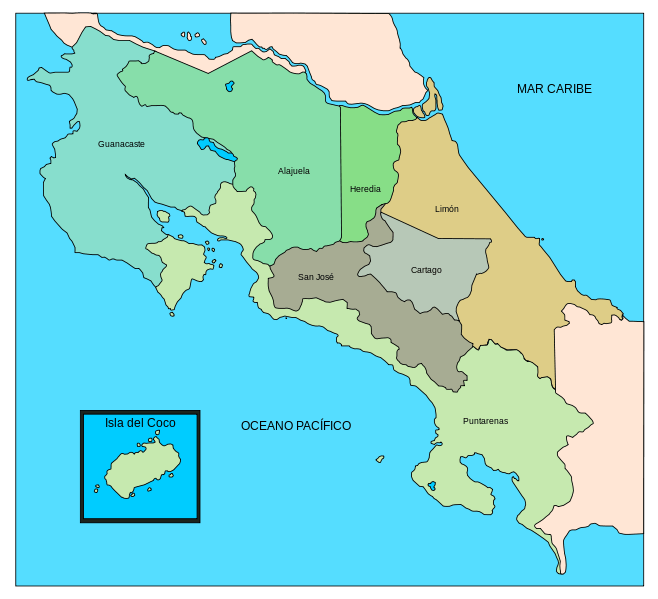
Map depicting the administrative provinces of Costa Rica
Geographic Regions (Zones)
Costa Rica can be divided into five distinct geographic regions.
-
Northern Plains: Costa Rica's Northern Plains region is a vast, fertile area home to various wildlife, including jaguars, monkeys, and sloths. The region also has several important national parks, including Arenal Volcano National Park, Palo Verde National Park, and Tortuguero National Park.
-
Northern Pacific Coast: Costa Rica's northern Pacific Coast is a beautiful region known for its white-sand beaches, calm waters, and lush vegetation. The area has several popular tourist destinations, including Tamarindo, Playa Flamingo, and Playa Potrero.
-
Central Pacific Coast: Costa Rica's Central Pacific Coast is a beautiful region known for its beaches, rainforests, and wildlife. The area has several popular tourist destinations, including Manuel Antonio National Park, Jaco Beach, and Dominical.
-
Central Valley: This is the most populous and developed region of Costa Rica. It is home to the capital city of San Jose and many other major cities and towns. The Central Valley is a fertile region with a mild climate, making it ideal for agriculture and tourism.
-
Caribbean Coastal Lowlands: This region is less developed than the Pacific Coast but is home to several vital ecosystems, including rainforests, mangroves, and swamps. The Caribbean Coast is also home to some indigenous communities.
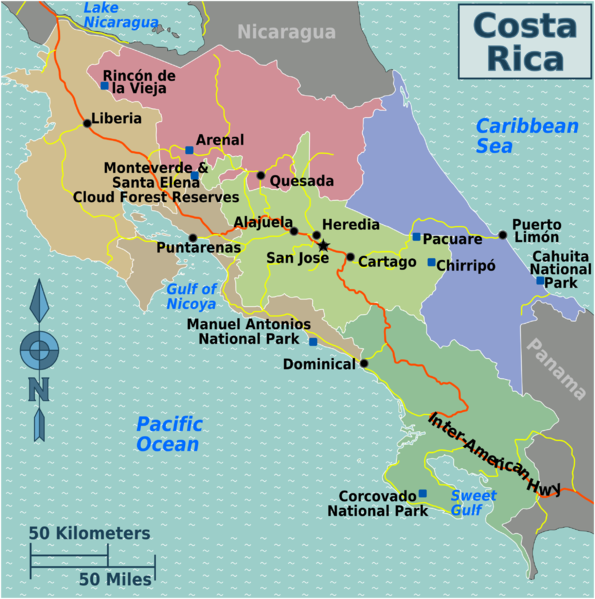
Map depicting the geographic regions of Costa Rica
Historical, Cultural, and Natural Landmarks
Costa Rica is renowned for its lush natural beauty, rich culture, and intriguing history. Here are some notable landmarks in each category, separated by region:
Northern Plains Region
The Northern Plains region of Costa Rica offers a mix of natural wonders, cultural experiences, and outdoor adventures. Here are some popular attractions in the area:
-
Arenal Volcano: One of the most iconic landmarks in Costa Rica, Arenal Volcano stands majestically over the town of La Fortuna. Visitors can hike on the trails surrounding the volcano, relax in hot springs, or participate in zip-lining, horseback riding, and canopy tours.
-
La Fortuna Waterfall: Located near the Arenal Volcano, La Fortuna Waterfall is a breathtaking cascade plunging into a pool surrounded by lush rainforest. Visitors can hike to the waterfall's base, take a refreshing swim, and enjoy the picturesque setting.
-
Arenal Lake: Arenal Lake is a large artificial reservoir created by the Arenal Volcano hydroelectric project. The lake offers opportunities for fishing, kayaking, stand-up paddleboarding, and boat tours. Enjoy the scenic beauty and the stunning backdrop of the volcano.
-
Caño Negro Wildlife Refuge: This protected wetland area is a haven for wildlife enthusiasts and birdwatchers. Embark on a boat tour through the Caño Negro River to observe a diverse array of bird species, as well as caimans, monkeys, and turtles.
-
Venado Caves: Explore an underground world in the Venado Caves, a series of limestone caves near Arenal. Join guided tours to venture deep into the caves, marvel at stalactites and stalagmites, and crawl through narrow passages.
-
Rio Celeste: Located in the Tenorio Volcano National Park, Rio Celeste is a mesmerizing turquoise river known for its striking coloration. Visitors can hike through the rainforest trails to witness the confluence of two rivers that create the magical blue hue.
-
Cano Negro Wildlife Refuge: Cano Negro Wildlife Refuge is another fantastic place for wildlife lovers. Take a boat tour on the Rio Frio, where you can spot various bird species, monkeys, caimans, and river otters.
-
Cote Lake: Cote Lake is a serene and picturesque lake near Upala. It offers opportunities for boating, fishing, and birdwatching. The lake is surrounded by lush vegetation, making it a tranquil retreat for nature enthusiasts.
-
Juan Castro Blanco National Park: This lesser-known national park is a hidden gem with cloud forests, volcanoes, and natural hot springs. It offers hiking trails, birdwatching, and the chance to soak in hot springs amidst a peaceful setting.
Northern Pacific Coast Region
The Northern Pacific Coast region of Costa Rica, also known as the Guanacaste region, is famous for its beautiful beaches, national parks, and outdoor activities. Here are some popular attractions in the area:
-
Tamarindo: Tamarindo is a bustling beach town known for its vibrant surf culture and lively atmosphere. It offers various water sports activities such as surfing, paddleboarding, and sport fishing. Visitors can enjoy the pristine beaches, explore the mangroves, or take a sunset cruise.
-
Santa Rosa National Park: This national park is located in the Guanacaste Conservation Area and is home to diverse ecosystems, including dry tropical forests and pristine beaches. It preserves important historical sites and offers hiking trails, wildlife viewing, and camping opportunities.
-
Rincon de la Vieja National Park: Located near Liberia, Rincon de la Vieja National Park is known for its active volcano, hot springs, and unique flora and fauna. Visitors can hike the park's trails to observe geothermal activity, visit waterfalls, and even take a mud bath in natural hot springs.
-
Papagayo Peninsula: The Papagayo Peninsula is a luxurious resort and beach destination. It offers pristine white-sand beaches, crystal-clear waters, snorkeling, diving, and sailing opportunities. Visitors can indulge in luxury accommodations and enjoy the amenities provided by the resorts.
-
Palo Verde National Park: This wetland reserve is a haven for birdwatching and wildlife enthusiasts. Located along the Tempisque River, Palo Verde National Park is home to many bird species, including migratory birds. Visitors can take boat tours to observe crocodiles, monkeys, and other wildlife.
-
Playa Flamingo: Playa Flamingo is a picturesque beach known for its stunning sunsets and calm waters. It offers a range of water activities, such as snorkeling, fishing, and sailing. The area is also known for its luxury resorts and upscale vacation rentals.
-
Playa Hermosa: Playa Hermosa is a popular beach destination for surfers and nature lovers. It offers consistent waves and a relaxed atmosphere. The beach is surrounded by lush tropical vegetation and is known for its nesting sea turtles.
-
Las Baulas National Marine Park: Located near Tamarindo, Las Baulas National Marine Park is a protected area known for its nesting grounds of endangered leatherback turtles. Visitors can take guided night tours to witness these incredible creatures nesting and hatching.
-
Guanacaste National Park: Guanacaste National Park is part of the UNESCO World Heritage Site called the Area de Conservación Guanacaste. The park protects dry tropical forests, volcanic formations, and important archaeological sites. It offers hiking trails and opportunities to observe wildlife like monkeys, birds, and coatimundis.
Central Pacific Coast Region
The Central Pacific Coast region of Costa Rica is known for its stunning beaches, national parks, and diverse marine life. Here are some popular attractions in the area:
-
Manuel Antonio National Park: This famous national park is renowned for its breathtaking combination of lush rainforest, pristine beaches, and abundant wildlife. Visitors can hike the park's trails, relax on the beautiful beaches, and spot monkeys, sloths, and various bird species.
-
Jacó: Jacó is a bustling beach town known for its surfing opportunities and vibrant nightlife. It offers a lively atmosphere, a wide range of water sports activities, and a variety of restaurants and bars.
-
Carara National Park: Nearr Jacó, Carara National Park is a birdwatcher haven. The park is home to over 400 bird species, including scarlet macaws. Visitors can hike the park's trails and spot monkeys, reptiles, and other wildlife.
-
Playa Herradura: Situated near Jacó, Playa Herradura is a beautiful horseshoe-shaped beach with calm waters. It offers opportunities for swimming, snorkeling, and kayaking. The nearby Los Sueños Marina is famous for sport fishing and boating.
-
Tarcoles River: The Tarcoles River is famous for its large population of crocodiles. Visitors can take boat tours to observe these impressive creatures up close while enjoying the river's diverse birdlife.
-
Punta Leona: Punta Leona is a private resort and nature reserve offering beautiful beaches, lush rainforests, and a variety of wildlife. Visitors can relax on the pristine beaches, go snorkeling, or take guided hikes to explore the area's natural wonders.
-
Playa Hermosa: Playa Hermosa, located south of Jacó, is a peaceful beach known for its tranquil atmosphere and scenic beauty. The beach is ideal for swimming, sunbathing, and enjoying the spectacular sunsets.
-
Playa Esterillos: Playa Esterillos is a long, wide beach known for its uncrowded and tranquil ambiance. It offers opportunities for horseback riding, beachcombing, and watching stunning sunsets.
-
Marino Ballena National Park: Although primarily located in the South Pacific region, Marino Ballena National Park extends to the Central Pacific Coast near Uvita. The park is known for its pristine beaches and the unique "Whale Tail," a sandbar formation visible during low tide. Visitors can enjoy snorkeling, swimming, and witnessing humpback whales during their migratory season.
Central Valley Region
The Central Valley region of Costa Rica is the country's cultural and economic hub, encompassing the capital city of San José and the surrounding areas.
While it may not be known for its natural wonders, the Central Valley offers a range of attractions that highlight Costa Rica's history, culture, and urban life. Here are some popular attractions in the Central Valley region:
-
San José: Costa Rica's capital city, San José, is a bustling urban center with a blend of historic and modern attractions. Visitors can explore the National Theater, visit museums such as the Gold and Jade Museum, stroll through the Central Market, and immerse themselves in the local culture and cuisine.
-
Poás Volcano: Located within Poás Volcano National Park, Poás Volcano is an active volcano with a steaming crater lake. Visitors can hike to the crater rim and witness the dramatic landscapes and volcanic activity. The park also offers nature trails and opportunities for birdwatching.
-
Irazú Volcano: Irazú Volcano is another active volcano in the Central Valley region. It features a massive crater and offers panoramic views of the surrounding landscapes on clear days. Visitors can hike to the summit and explore the volcanic terrain.
-
Orosi Valley: Nestled in the mountains of the Central Valley, the Orosi Valley is known for its picturesque landscapes, coffee plantations, and colonial architecture. Visitors can explore the charming town of Orosi, visit the colonial church, and enjoy the valley's scenic beauty.
-
La Paz Waterfall Gardens: Located near Poás Volcano, La Paz Waterfall Gardens is a private nature reserve featuring stunning waterfalls, botanical gardens, and a variety of wildlife. Visitors can hike the trails, observe colorful birds butterflies, and visit the butterfly and hummingbird gardens.
-
Cartago: Cartago is a historic city and the former capital of Costa Rica. It offers architectural gems such as the Basilica de Nuestra Señora de los Ángeles, an important pilgrimage site. Visitors can also explore the Cartago Ruins and learn about the city's colonial past.
-
Coffee Plantations: The Central Valley is known for its coffee production, and several coffee plantations offer tours where visitors can learn about the coffee-making process, taste local brews, and explore the lush coffee fields.
-
University of Costa Rica: The University of Costa Rica's main campus is in San José. It features beautiful gardens, historic buildings, and cultural events. Visitors can explore the campus and enjoy its vibrant academic atmosphere.
-
Sarchí: Sarchí is a small town famous for its skilled artisans and traditional crafts, particularly the elaborately painted oxcarts. Visitors can visit workshops, purchase handcrafted souvenirs, and learn about Costa Rican craftsmanship.
Caribbean Coastal Lowlands Region
The Caribbean coastal lowlands region of Costa Rica offers a unique blend of stunning beaches, lush rainforests, and vibrant Afro-Caribbean culture. Here are some popular attractions in the area:
-
Tortuguero National Park: Known as the "Amazon of Costa Rica," Tortuguero National Park is a biodiverse reserve encompassing canals, lagoons, and dense rainforest. It is a prime nesting site for endangered green sea turtles, and visitors can witness turtle nesting and hatching during the nesting season. The park also offers opportunities for wildlife spotting, birdwatching, and guided boat tours.
-
Cahuita National Park: Located near Cahuita, Cahuita National Park protects a pristine coral reef and lush coastal rainforest. Visitors can snorkel or dive to explore the vibrant coral reef teeming with tropical fish, walk along the scenic coastal trail, and encounter wildlife such as howler monkeys, sloths, and colorful birds.
-
Puerto Viejo de Talamanca: Puerto Viejo is a laid-back coastal town known for its picturesque beaches and vibrant Afro-Caribbean culture. It offers a relaxed atmosphere, reggae music, and delicious Caribbean cuisine. Visitors can enjoy surfing, swimming, sunbathing, and exploring the town's unique blend of cultures.
-
Gandoca-Manzanillo Wildlife Refuge: Located south of Puerto Viejo, the Gandoca-Manzanillo Wildlife Refuge is a protected area known for its diverse ecosystems, including beaches, wetlands, and rainforests. Visitors can hike through the trails, go wildlife spotting, or take guided kayak tours through the mangroves.
-
Sloth Sanctuary: The Sloth Sanctuary near Cahuita is a rescue and rehabilitation center dedicated to protecting and conserving sloths. Visitors can learn about these fascinating creatures, take guided tours, and even have the opportunity to interact with baby sloths.
-
Limón: Limón is the central port city on the Caribbean coast of Costa Rica and serves as a gateway to the region. While it may not be a typical tourist destination, it offers a vibrant Afro-Caribbean atmosphere, colorful architecture, and the opportunity to experience local markets and festivals.
-
Indigenous Communities: The Caribbean coastal lowlands region is home to various indigenous communities, such as the BriBri and Kekoldi. Visitors can learn about their traditional way of life, participate in cultural activities, and even stay in eco-lodges within these communities.
-
Waterfalls: The region has beautiful waterfalls, such as the popular Chasing Waterfalls tour near Puerto Viejo. Visitors can hike through the rainforest to discover these hidden gems and take refreshing dips in the crystal-clear pools.
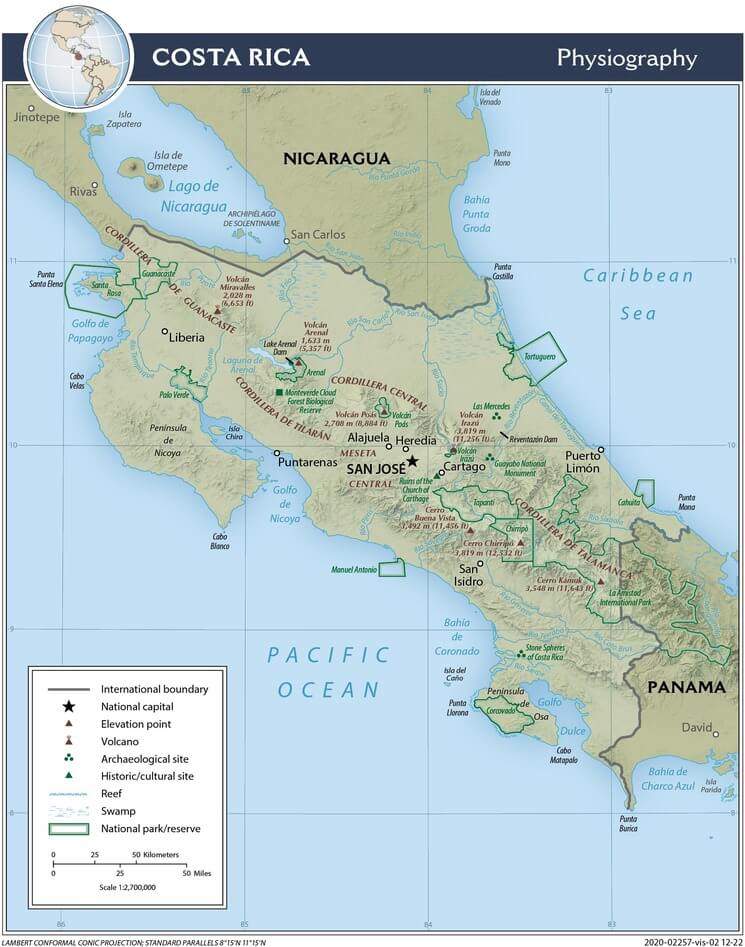
Costa Rica physiographic map
